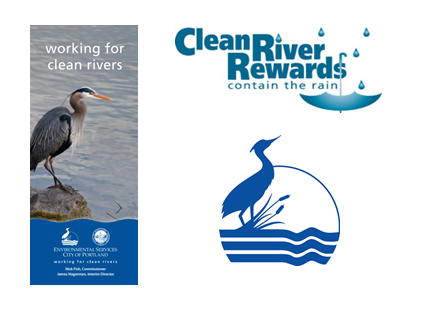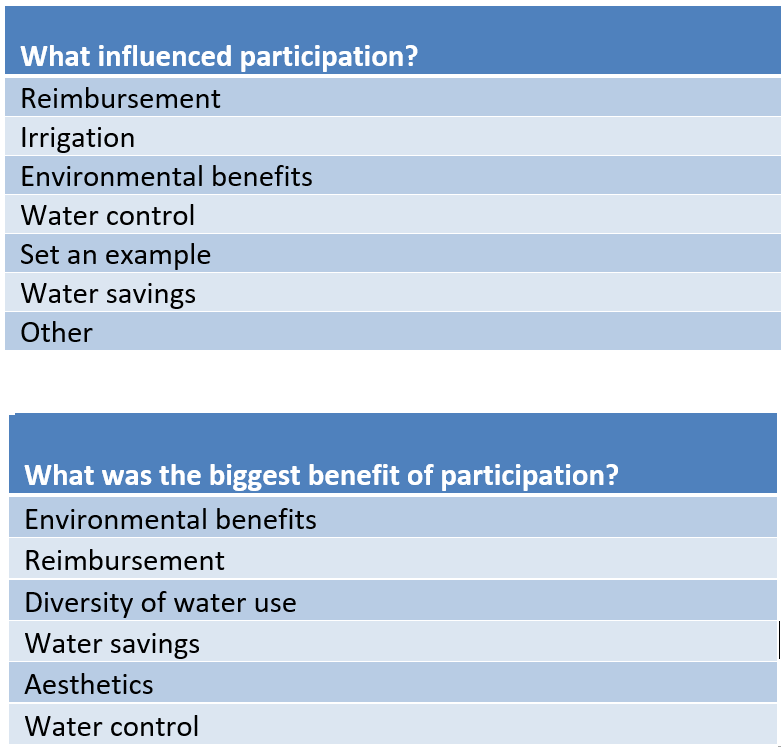Stormwater incentive programs are a creative tool used by some towns and cities to encourage community participation in stormwater management practices. Many of the incentive programs encourage citizens to install green stormwater infrastructure projects on their property. Stormwater ‘incentive’ programs can be found in municipalities across the United States and can take on a variety of formats; rebates, grants, cost sharing, and loans are some of the most popular methods. These programs usually offer incentives for both commercial and residential property owners, and they encourage projects like rain gardens, cisterns, rain barrels, green roofs, bioswales, permeable pavers, and native tree plantings.
Projects like this help improve the water quality of impacted water bodies by preventing pollutants from entering waterways and mitigating flooding problems in impacted areas. While the benefit of using these practices is substantial, offering financial incentives tends to boost interest from property owners to participate in such programs.
The City of Raleigh’s Stormwater Quality Cost Share Program encourages the use of stormwater management measures on private property by offering cost share funds to both residential and commercial property owners who add qualifying projects to their property that capture and store stormwater runoff. The program is funded through the City’s stormwater utility fee and covers up to 90 percent of the cost of eligible green infrastructure projects.
In addition to improving water quality, the program has the potential for increasing community interest in and support for stormwater and water quality improvement programs. With support from the National Fish and Wildlife Foundation and Wells Fargo, the Environmental Finance Center at the University of North Carolina at Chapel Hill has worked with the City of Raleigh to identify communication best practices designed to encourage public participation in the program.
These findings were based on communications literature and interviews with past program participants. While there are many ways to design incentive programs to maximize participation rates, this post focuses on our top five recommendations for how to best communicate the program to encourage participation:
Encourage Word of Mouth Referrals
In order to gather feedback for the City of Raleigh regarding what could be done to improve the program and make the process easier, we interviewed several past participants. The interviews revealed that many participants heard about the program from a neighbor or coworker who previously participated in the program. The literature on other stormwater and energy efficiency programs backs up this point. For example, in Washington D.C.’s RiverSmart Homes Program, researchers found that “word of mouth is the main way households hear about the program and how participants gain interest.” In addition, 48.9 percent of respondents say they participated due to recommendations from a friend or family member or participant in the program.
So how can a program encourage word of mouth referrals?
Linking Participants
When we interviewed Raleigh’s participants, every respondent told us they would recommend the program to a friend or family member. Many of them said that they had already recommended it. Additionally, many participants expressed they would be interested in receiving help and guidance from other individuals in the program, including coordinating visits to view their own stormwater projects.
Other Resources
- Programs should consider partnering with allies like non-profits who share similar interests. These organizations may be helpful to spread the word. Developing educational materials for these partners to distribute is an important part of this process because it gives individuals something tangible to reference when considering the program.
- Programs should also host workshops, one-on-one conversations, and produce written materials for distribution to the public (like brochures, videos, and door hangers). Many of the participants interviewed for Raleigh’s program discovered it through community associations or neighborhood meetings. Ideal allies would have strong ties to the community. These can also be schools and faith-based organizations.
Create a Demonstration Site or Promote Example Installations
Even providing signs to participants to keep in their yards near their stormwater projects can help increase visibility and education for the program. Well-maintained and properly-signed demonstration sites in visible areas provide good publicity and promote positive social influence. According to The University of Florida:
“For some groups of people, an example of a functional and beautiful planting in and around a pond may be necessary for them to adopt pond plantings and empower those interested to create a good design.”
Demonstration projects should be well maintained and easy to understand. The research suggests that badly maintained, poorly functioning, or over complicated demonstration sites can deter people from participating.
Using demonstration sites can be as simple as developing a list of participants who are willing to show their projects to interested individuals. More comprehensively, programs could develop a tour of sites at a neighborhood or municipality wide level. For example, Portland, Oregon, developed the Stormwater Cycling Tour to showcase green infrastructure projects in the city and has a seen a high rate of uptake in their program.
Remember Your Target Audience
It is important to keep in mind who your target community is when creating signs and designating demonstration sites. For example, in communities with a large Spanish-speaking population, signs with both Spanish and English language information are beneficial (see example from Fayetteville Stormwater). You can also apply this logic to other target audiences; just think about crafting your message. This is especially important because signage can increase participation through social pressure and helps educate people about what function the BMP serves.
Train Contractors to Serve as Program Allies
Our research shows that well-trained contractor-installers are key to a program’s success. When BMP contractors and installers are trained on how to best implement, maintain, and promote stormwater projects, they are an extremely beneficial asset in raising program participation.
Many programs train contractors themselves. For example, In Burlington, Vermont, the city’s Let It Rain program provides webinar trainings for contractors on BMP practices and installations. Webinar participation lists are then used as a list of approved vendors that can be given to interested participants (Water Environment Federation).Let it Rain states that, “training local contractors, partnering with suppliers, and placing signage at green infrastructure facilities can improve dissemination of a message.”
Making Installation Easier
When contractors are educated about program specifics and can help guide participants through the process, the ease of installation and maintenance are major drivers for participation in these initiatives. Further, contractors educated on program specifics can help promote the program through word of mouth referrals. One of the commercial property managers we interviewed stated that he wanted a contractor who was educated enough on program specifics to do most of the “leg work” for him. This kind of relationship is appealing for those who may not participate otherwise. Once again, ease of participation is important to keep in mind.
Branding and Name Recognition
Develop a name and brand for your program that reflects how you want your target audience to view you. A brand can be simply a name, or a symbol, mascot, or picture that consistently conveys your image.
Many successful programs incorporate water bodies and water language into their branding and imaging.
- The Let it Rain program in Burlington, Vermont, ran an outreach campaign called Connecting the Drops. The program’s director said that in hindsight, they should have called it Let it Rain to reduce confusion.
- The Clean River Rewards stormwater utility discount program in Portland, Oregon, is run by Portland Environmental Services and incorporates the department’s logo into its communications. The logo itself matches the picture used on the utility bill insert (Environmental Services City of Portland).

Good Website Design/Information
When working on your program’s website, consider how to attract those who are typically uninterested in or do not understand stormwater management. If your website only reflects information on the logistics of the program but does not convince anyone to use it, it will only appeal to a small audience — those who are already considering a project.
Residential
For residential properties, framing stormwater programs in terms of benefits to the homeowner or benefits to the environment are often successful. The following are benefits touted by the participants in Raleigh’s program:

Again, remember your target audience. Be careful to adapt communications to your audience: who do you want your target audience to be?
- Develop personalized messaging for each audience you want to reach.
- In developing communications, ask, “What matters to them?” “Why should they participate?”
Businesses/Commercial Properties
For businesses, emphasize the positive business contributions of a Best Management Practice (BMP). This could include potential increase in traffic to their site or store. Customers will likely stop to read BMP signs and look at the installation. This is especially true when BMPs are visible from the sidewalk. In addition, it is important to emphasize that BMPs will not harm their business. Many commercial sites express this concern during site visits. Promoting green business strategies will help support some commercial interests, and will be particularly beneficial if they live in an area where green practices are important to customers.
Targeted messaging is important because effective communications will be different for residential and commercial properties, and possibly from neighborhood to neighborhood.
Further Resources
Stormwater programs like Raleigh’s Stormwater Quality Cost Share Program help community members afford installations that can be beneficial to both their property and the environment. Uptake has traditionally been low in these and other energy saving programs, despite the financial benefits to participants. We hope the tips outlined above will help increase participation for these important programs that can beautify properties while also decrease the amount of pollution going into water bodies.
For more resources related to stormwater and stormwater programs check out these other EFC at UNC blog posts:
- State of Stormwater Fees in North Carolina
- A Whole New World—of Stormwater | GA Stormwater Dashboard
- Challenges in Financing Distributed Infrastructure
- Green Infrastructure: What it is and how it can help your city
- All Stormwater Posts
Tara Nattress is pursuing her Master’s of Public Administration in the School of Government at the University of North Carolina at Chapel Hill and works as a research assistant for the Environmental Finance Center.


One Response to “Five Communication Tips for Stormwater Incentive Programs”
CCTV Drain Inspection Services
Thanks for this information, it’s just what I was looking for!